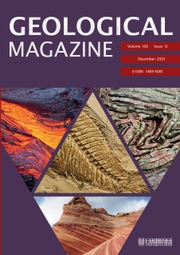Crossref Citations
This article has been cited by the following publications. This list is generated based on data provided by
Crossref.
Sajeev, K.
Osanai, Y.
Connolly, J. A. D.
Suzuki, S.
Ishioka, J.
Kagami, H.
and
Rino, S.
2007.
Extreme Crustal Metamorphism during a Neoproterozoic Event in Sri Lanka: A Study of Dry Mafic Granulites.
The Journal of Geology,
Vol. 115,
Issue. 5,
p.
563.
Tsunogae, Toshiaki
Santosh, M.
Ohyama, Hiroyuki
and
Sato, Kei
2008.
High-pressure and ultrahigh-temperature metamorphism at Komateri, northern Madurai Block, southern India.
Journal of Asian Earth Sciences,
Vol. 33,
Issue. 5-6,
p.
395.
Fontanelli, Paola De Rossi
De Ros, Luiz Fernando
and
Remus, Marcus Vinicius Dorneles
2009.
Provenance of deep-water reservoir sandstones from the Jubarte oil field, Campos Basin, Eastern Brazilian Margin.
Marine and Petroleum Geology,
Vol. 26,
Issue. 7,
p.
1274.
Sato, Kei
Santosh, M.
and
Tsunogae, Toshiaki
2009.
A petrologic and laser Raman spectroscopic study of sapphirine–spinel–quartz–Mg-staurolite inclusions in garnet from Kumiloothu, southern India: Implications for extreme metamorphism in a collisional orogen.
Journal of Geodynamics,
Vol. 47,
Issue. 2-3,
p.
107.
Santosh, M.
Maruyama, Shigenori
and
Sato, Kei
2009.
Anatomy of a Cambrian suture in Gondwana: Pacific-type orogeny in southern India?.
Gondwana Research,
Vol. 16,
Issue. 2,
p.
321.
Kanazawa, Tomohito
Tsunogae, Toshiaki
Sato, Kei
and
Santosh, M.
2009.
The stability and origin of sodicgedrite in ultrahigh-temperature Mg-Al granulites: a case study from the Gondwana suture in southern India.
Contributions to Mineralogy and Petrology,
Vol. 157,
Issue. 1,
p.
95.
Naganjaneyulu, K.
and
Santosh, M.
2011.
Crustal architecture beneath Madurai Block, southern India deduced from magnetotelluric studies: Implications for subduction–accretion tectonics associated with Gondwana assembly.
Journal of Asian Earth Sciences,
Vol. 40,
Issue. 1,
p.
132.
Shazia, J.R.
Santosh, M.
and
Sajeev, K.
2012.
Peraluminous sapphirine–cordierite pods in Mg-rich orthopyroxene granulite from southern India: Implications for lower crustal processes.
Journal of Asian Earth Sciences,
Vol. 58,
Issue. ,
p.
88.
Shazia, J.R.
Harlov, D.E.
Suzuki, K.
Kim, S.W.
Girish-Kumar, M.
Hayasaka, Y.
Ishwar-Kumar, C.
Windley, B.F.
and
Sajeev, K.
2015.
Linking monazite geochronology with fluid infiltration and metamorphic histories: Nature and experiment.
Lithos,
Vol. 236-237,
Issue. ,
p.
1.
OSANAI, Yasuhito
SAJEEV, Krishnan
NAKANO, Nobuhiko
KITANO, Ippei
KEHELPANNALA, Wilbert K.V.
KATO, Ryosuke
ADACHI, Tatsuro
and
MALAVIARACHCHI, Sanjeewa P.K.
2016.
UHT granulites of the Highland Complex, Sri Lanka II: Geochronological constraints and implications for Gondwana correlation.
Journal of Mineralogical and Petrological Sciences,
Vol. 111,
Issue. 3,
p.
157.
Azhar Ul Haq, Mohd
Balakrishnan, S
Bhutani, Rajneesh
and
Dash, Jitendra K
2021.
Causal relationship between mafic magma underplating and migmatization of arc crust: Evidence from the Madras block of Southern Granulite terrane, India.
Journal of Earth System Science,
Vol. 130,
Issue. 3,
Mandal, Biswajit
Vijaya Rao, V.
Karuppannan, P.
Raju, S.
and
Ganguli, Shib Sankar
2021.
Thick-skinned tectonics of the Achankovil Shear Zone, southern India, inferred from new deep seismic reflection image: Constraints on the East African Orogen.
Precambrian Research,
Vol. 356,
Issue. ,
p.
106110.
Yadav, Roopali
Prakash, Divya
Rai, Swapnil Kumar
Yadav, Manoj Kumar
Jaiswal, Srishti
Singh, Saurabh
Singh, Pradip Kumar
Kumar, Manish
and
Singh, Chandra Kant
2021.
Ultrahigh-temperature decompression of sapphirine-granulites from the southern Madurai block (South India): Insights from geothermobarometry, pseudosection modelling and U-Pb geochronology.
Journal of Asian Earth Sciences,
Vol. 218,
Issue. ,
p.
104861.
Durgalakshmi,
Sajeev, K
Williams, Ian S
Reddy, D Harinadha
Satish-Kumar, M
Jöns, Niels
Malaviarachchi, Sanjeewa P K
Samuel, Vinod O
and
George, P M
2021.
The Timing, Duration and Conditions of UHT Metamorphism in Remnants of the Former Eastern Gondwana.
Journal of Petrology,
Vol. 62,
Issue. 12,
Ray, Srijita
Tiwari, Ashish Kumar
and
Sarkar, Tapabrato
2021.
Ultrahigh‐temperature mafic granulites from the Madurai Block, southern India: Constraints from conventional thermobarometry, pseudosection analysis, and rare earth element‐based thermometry.
Geological Journal,
Vol. 56,
Issue. 7,
p.
3720.
Tiwari, Ashish Kumar
Sarkar, Tapabrato
Karmakar, Sourav
Sorcar, Nilanjana
and
Mukherjee, Sneha
2023.
Long‐lived high‐grade metamorphism in southern India: Constraints from charnockites and sapphirine‐bearing semipelitic granulites from the Madurai Block.
Journal of Metamorphic Geology,
Vol. 41,
Issue. 9,
p.
1261.




